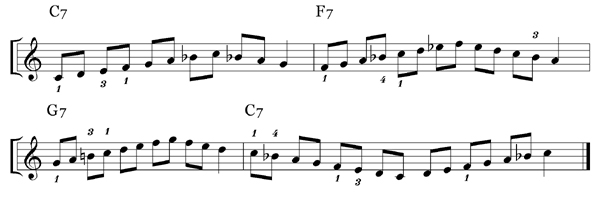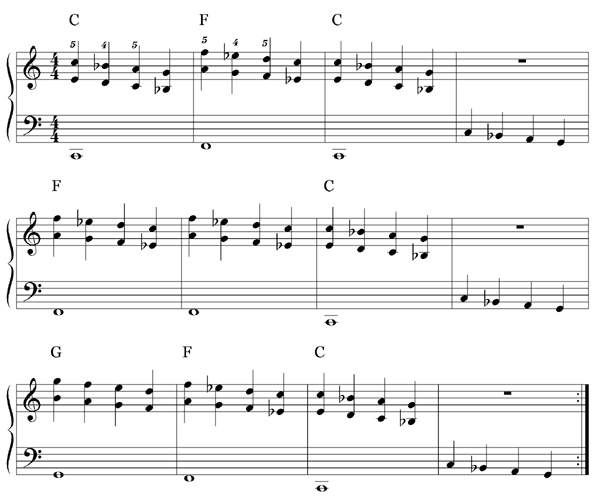Musicarta Twelve-bar Piano Styles
Cascading Sixths
You have seen in the Moving Pair series how a third can invert to a sixth and then move around in much the same way. This means you can harmonise a different note –the top note, which is the one that the ear naturally listens out for.
Cascading Sixths explores harmonising with sixths within a twelve bar chord sequence. Here is the performance video, with the audio and MIDI reference blow.
Preparing your performance
First, rehearse the dominant scales of the three I, IV, V chords you would expect to hear in a twelve-bar in C.

The sixths we are selecting for Cascading Sixths are the first four from the root down.

Use fingers 5-1, 4-1 as shown or finger the sixths 5-1 throughout.
Cascading Sixths skeleton music
These twelve intervals (pairs of notes) are quite enough for a short piece. Here is the Cascading Sixths ‘skeleton music’ – before any syncopation or bass line development.

The audio and MIDI files for this skeleton music are cut off precisely at bar-end, making them ideal for looping and playing along to – the best practising arrangement.
Adding syncopation
Now work in the basic syncopation. The rhythm used is the same throughout. Absorb the counting written between the staves – learn to say it out loud. Only one line of MS is given – simply apply the same rhythm to all the ‘skeleton music’.

Transpose!
This ‘simple material with syncopation for show’ type of piece is perfect for practising your transposing. All the module MIDI files transposed into D for you to work with are included in your download and referenced in your workbook.
The three chords/scales you will work with are D7, G7
and A7. Expect the fingering to change with the new F and C sharps. Here are the audio files for you to check your progress. The performance is at the end, after the build-up.
|
|
|
|
|
|
OUT NOW! |
THE MUSICARTA BEAT & RHYTHM WORKBOOK At last! An effective approach to keyboard rhythm & syncopation skills. Learn more! |
ONLY $24.95! |
The MusicartaA methodical approach to keyboard syncopation for
|
PUBLICATIONS
exciting keyboard
creativity courses
CHORDS 101
WORKBOOK

~HANON~
video course

Musicarta
Patreon
PENTATONICS
WORKBOOK
video course

Creative Keyboard
video course

BEAT AND RHYTHM
WORKBOOK

- Volume 1 -

12-BAR PIANO
STYLES WORKBOOK

MUSICARTA MODES
WORKBOOK

PIANO STYLE

CANON PROJECT
video course

VARIATIONS
video course


- Piano Solo -
video course

- Piano Solo -


YouTube playlists





 THE LOGO
THE LOGO
